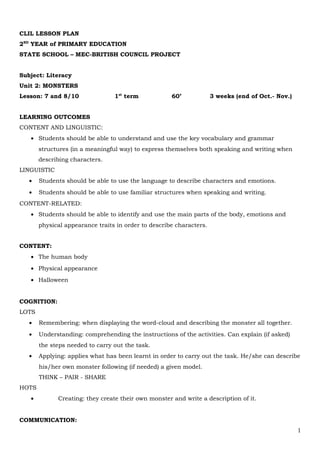
Clil lesson plan monsters
- 1. CLIL LESSON PLAN 2ND YEAR of PRIMARY EDUCATION STATE SCHOOL – MEC-BRITISH COUNCIL PROJECT Subject: Literacy Unit 2: MONSTERS Lesson: 7 and 8/10 1st term 60’ 3 weeks (end of Oct.- Nov.) LEARNING OUTCOMES CONTENT AND LINGUISTIC: • Students should be able to understand and use the key vocabulary and grammar structures (in a meaningful way) to express themselves both speaking and writing when describing characters. LINGUISTIC • Students should be able to use the language to describe characters and emotions. • Students should be able to use familiar structures when speaking and writing. CONTENT-RELATED: • Students should be able to identify and use the main parts of the body, emotions and physical appearance traits in order to describe characters. CONTENT: • The human body • Physical appearance • Halloween COGNITION: LOTS • Remembering: when displaying the word-cloud and describing the monster all together. • Understanding: comprehending the instructions of the activities. Can explain (if asked) the steps needed to carry out the task. • Applying: applies what has been learnt in order to carry out the task. He/she can describe his/her own monster following (if needed) a given model. THINK – PAIR - SHARE HOTS • Creating: they create their own monster and write a description of it. COMMUNICATION: 1
- 2. LANGUAGE OF LEARNING • Vocabulary of the body, emotions and physical appearance. LANGUAGE FOR LEARNING • Body language and language structures (This is… He or She is/ has got…) to describe characters LANGUAGE THROUGH LEARNING • Recycle previous knowledge of the human body, emotions, physical appearance and adjectives. • New vocabulary provided by the story CULTURE: • Be aware of how certain festivals are celebrated in another culture: Halloween. PROCEDURE: WARMING-UP ACTIVITY: • We show the cover of the book “Flanimals” and ask what the title suggests to them and what the book may be about (in previous sessions we have worked on other books that support the topic and content) • We read the book all together (depending on the time, we may choose to read only some of the descriptions that come up) MAIN ACTIVITIES: • We project the word-cloud completed in previous sessions on the whiteboard. This way students will have all the vocabulary needed available. • All together we describe the monster in the cover and write it on the blackboard. • Think-Pair-Share: Students may choose a monster from the book or make up their own. They get time to think (individually), pair (tell their partner), and share (some will share with the rest of the class). • Student’s will draw and write a description of the monster they like on a piece of paper. They can use their notebooks to check for useful infromation or ask each other for help if needed. ROUND-UP ACTIVITY: • Students can share their monster´s description with the rest of the class. • We display all their work and play guess who in groups (a member of the group must describe a monster and the rest guess) INSTRUMENTS FOR ASSESSMENT AND EVALUATION CRITERIA: • Observation: check if they can describe a monster in the “Think-Pair-Share” dynamic. 2
- 3. • Take notes: when describing monsters in groups (“Who is Who” game), check if they use relevant vocabulary. • Final task: uses topic vocabulary and proper structures when describing his/her monster. RESOURCES: • Book: Flanimals SCAFFOLDING: • Today we are going to read a new book, Flanimals. Have a look at the cover, what do you think the book will be about? • We are going to describe the Flanimal on the cover, can you tell me what you can see? WHEN DESCRIBING • Will we say he or she? He (pointing to a girl) is a boy? Elicit the correct answer. • An error like the following may appear: He has got EYES PURPLE?!?! Think! THINK – PAIR – SHARE • Now think of a monster, the one you like. You can choose one from the book or make it up. You have a couple of minutes (show 2 with fingers). Now share it with your partner. He or she can help you if you have trouble. • Can you explain again what you have to do? Does everybody understand? • Remember you have the posters to help you (done in previous sessions), the word-cloud with lots of words here to check or your Science books if you need to look up more words. • Don’t forget to use the Tricky (sight) Words posters when you write! (he, she, the, etc.) • Off you go! Now it’s your turn to write your own description. • Remember! You can ask a friend or me if you like, but always in English! • Who wants to share his/her description with the rest? Great! AFTER DISPLAYING THEIR WORK • Let’s play a game, it’s like the one we played of riddles but with your monsters. You must choose one in your head and describe it to the rest as best as you can so they can guess it! NOTES: - Difficulties during the class: 3
- 4. - Specific needs: depending on the level, instead of writing full sentences they can draw and just write the vocabulary used related to the body, numbers and colours (displayed on wall). E.g. blue eyes, five ears, six teeth, etc. - Things to improve: - To continue the next day: Book: Parts. Read story all together. Venn Diagram (compare the boy and the Gruffalo) This/these sessions are included in a 3-4 weeks unit. Through the topic of Halloween we will work on the body, physical appearance and emotions. The following resources are included in the unit: Books: Knock Knock Who’s There?; The Gruffalo; Parts. Videos: Wiki for Kids Halloween Video; In a Dark Dark… Songs: The Skeleton Dance; The Gruffalo’s Song 4